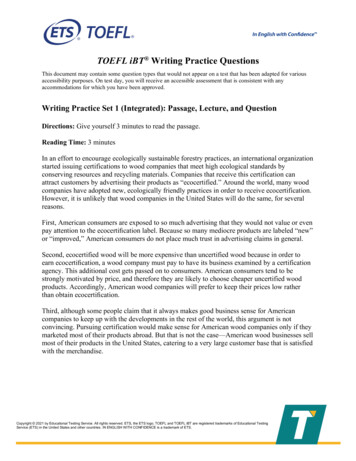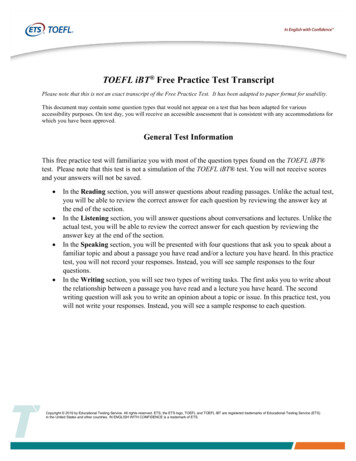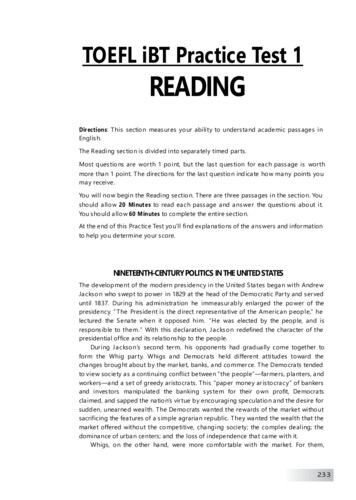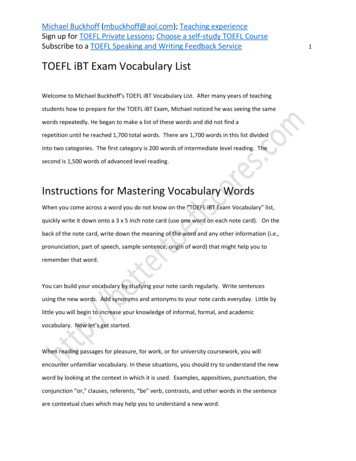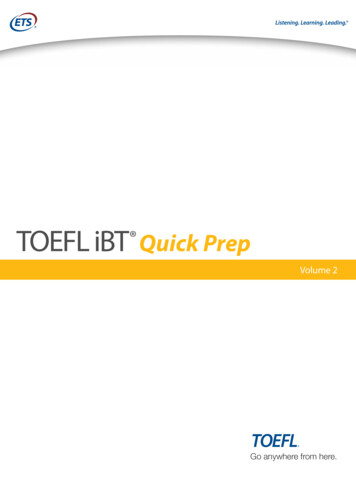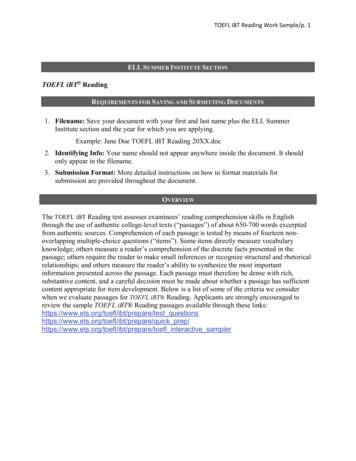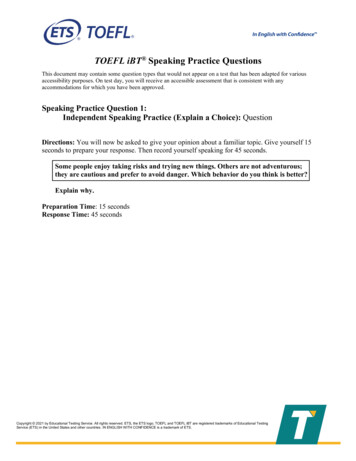
Transcription
TOEFL iBT Speaking Practice QuestionsThis document may contain some question types that would not appear on a test that has been adapted for variousaccessibility purposes. On test day, you will receive an accessible assessment that is consistent with anyaccommodations for which you have been approved.Speaking Practice Question 1:Independent Speaking Practice (Explain a Choice): QuestionDirections: You will now be asked to give your opinion about a familiar topic. Give yourself 15seconds to prepare your response. Then record yourself speaking for 45 seconds.Some people enjoy taking risks and trying new things. Others are not adventurous;they are cautious and prefer to avoid danger. Which behavior do you think is better?Explain why.Preparation Time: 15 secondsResponse Time: 45 secondsCopyright 2021 by Educational Testing Service. All rights reserved. ETS, the ETS logo, TOEFL and TOEFL iBT are registered trademarks of Educational TestingService (ETS) in the United States and other countries. IN ENGLISH WITH CONFIDENCE is a trademark of ETS.
Speaking Practice Question 1:Independent Speaking Practice (Explain a Choice): Response TipsTo respond to this particular question, you should clearly state what your opinion is: Do youthink it is better to take risks or to be cautious? Then you should give reasons to support youropinion. If you take the position that you think it is better to take risks and try new things, youmight give an example of a time when you or someone you know took a risk and was rewarded.The example should have good details, and the relationship between the example and youropinion should be clear. If you take the position that it is better to be cautious, you might give anexample of a situation where being cautious is beneficial. You might continue to develop theresponse by contrasting what would happen in this situation if a risk were taken.Keep in mind that there is no “correct” answer to this question. Either behavior can be supportedwith examples. The important part of this task is to make sure that you state your opinion anddevelop your response with good examples and relevant details.As with all speaking tasks, your response should be intelligible, should demonstrate effective useof grammar and vocabulary, and should be well developed and coherent. This task is scoredusing the Independent Speaking Rubrics.https://www.ets.org/s/toefl/pdf/toefl speaking rubrics.pdfCopyright 2021 by Educational Testing Service. All rights reserved. ETS, the ETS logo, TOEFL and TOEFL iBT are registered trademarks of Educational TestingService (ETS) in the United States and other countries. IN ENGLISH WITH CONFIDENCE is a trademark of ETS.
Speaking Practice Question 2:Integrated Speaking Practice (Campus-Related): Passage, Conversation,and QuestionDirections: The University is making a change in the courses it will offer. Read the article fromthe university newspaper about the change. Give yourself 45 seconds to read the article.Sculpture Courses to Be DiscontinuedUniversity administrators announced yesterday that the sculpture program, a division of the artdepartment, will be eliminated. “The main reason is a lack of student interest,” reported oneadministrator. “Although the number of art students has increased, fewer and fewer art majorsare taking sculpture classes.” Furthermore, the department’s only sculpture professor is retiringthis year. “Given the art department’s limited budget,” the administrator explained, “it justdoesn’t make sense to hire a new full-time professor to teach sculpture for only a handful ofstudents.”Copyright 2021 by Educational Testing Service. All rights reserved. ETS, the ETS logo, TOEFL and TOEFL iBT are registered trademarks of Educational TestingService (ETS) in the United States and other countries. IN ENGLISH WITH CONFIDENCE is a trademark of ETS.
Directions: Read the transcript.NarratorNow listen to two students discussing the article.Male studentEverything alright?Female student Yeah, I’m just upset about that article I showed you this morning Male studentWhy, what’s the big deal?Female student Well, as an art major, I think it’s a big loss for the department. The university’sgot it all wrong.Male studentWhat do you mean?Female student Well, the low enrollment isn’t because art majors don’t want to take theseclasses. Problem is, who has time to take them when there are so many otherrequirements?Male studentI don’t understand.Female student See, the classes they’re eliminating are all optional. The required courses aremostly painting and drawing, and they take up all our time. What we really needare different requirements—then art majors could take a better variety of classes all the things we’re interested in.Male studentThat makes sense. But, the thing about the professor Female student Well, that’s true. But still, they’re being drastic. If money’s the problem, theycould hire a part-time professor! Or, most of the professors in the departmenthave secondary fields Male studentReally?Female student Yeah! At least a few painting teachers are also great sculptors. I’m sure one ofthem could teach a class.Copyright 2021 by Educational Testing Service. All rights reserved. ETS, the ETS logo, TOEFL and TOEFL iBT are registered trademarks of Educational TestingService (ETS) in the United States and other countries. IN ENGLISH WITH CONFIDENCE is a trademark of ETS.
Directions: Give yourself 30 seconds to prepare your response to the following question. Thenrecord yourself speaking for 60 seconds.The woman expresses her opinion of the university’s plan. State her opinion andexplain the reasons she gives for holding that opinion.Preparation Time: 30 secondsResponse Time: 60 secondsCopyright 2021 by Educational Testing Service. All rights reserved. ETS, the ETS logo, TOEFL and TOEFL iBT are registered trademarks of Educational TestingService (ETS) in the United States and other countries. IN ENGLISH WITH CONFIDENCE is a trademark of ETS.
Speaking Practice Question 2:Integrated Speaking Practice (Campus-Related): Response TipsTo respond to this particular question, you should state the woman’s opinion of the university’splan to discontinue the sculpture courses. In this case, the woman disagrees with the university’splan and she believes that it is a “big loss for the department.”After stating the woman’s opinion, you should convey the two main reasons she gives forholding her opinion. You will need to connect information from the conversation to the readingin order for the response to be complete. The woman argues that the reason for the lowenrollment is because students who are art majors do not have time to take the sculpture classes,which are optional. A fully developed response might even point out that the reason for lowenrollment is not lack of student interest as the university claims in the reading. You could alsopoint out that students would probably take sculpture classes if the university changed therequirements.Your response should also convey the woman’s second reason for not agreeing with theuniversity’s plan: She believes that the university would not need to hire a full-time professor,and that a part-time professor or other professor could teach the class. You might also mentionthat the university’s claim in the reading that it cannot afford a full-time professor is thereforeunfounded. You could also point out that most of the professors have secondary fields and mightbe available to teach sculpture classes.As with all speaking tasks, your response should be intelligible, should demonstrate effective useof grammar and vocabulary, and should be well developed and coherent. This task is scoredusing the Integrated Speaking Rubrics.https://www.ets.org/s/toefl/pdf/toefl speaking rubrics.pdfCopyright 2021 by Educational Testing Service. All rights reserved. ETS, the ETS logo, TOEFL and TOEFL iBT are registered trademarks of Educational TestingService (ETS) in the United States and other countries. IN ENGLISH WITH CONFIDENCE is a trademark of ETS.
Speaking Practice Question 3:Integrated Speaking Practice (Academic): Passage, Lecture, and QuestionDirections: Read a passage about revealing coloration from a biology textbook. You have 45seconds to read the passage. Begin reading now.Revealing ColorationMany animals use coloration to protect themselves from predators. One defensive strategyinvolving the use of coloration is what is known as revealing coloration. Animals employing thisstrategy have an area of bright color on some part of their body; this bright color is usuallyhidden from predators’ view. When approached by a predator, the animal suddenly reveals thearea of bright color; this unexpected display of color startles or confuses the predator andprovides the would-be prey with an opportunity to escape.NarratorNow listen to part of a lecture from a biology class.ProfessorThere’s a large tropical insect called the peanut bug—yes, like the peanuts that youeat—uh, and the peanut bug’s front wings are colored so that they blend in withtheir surroundings. But its back wings—which are usually closed and hidden—have these bright, colorful spots on them. And when the peanut bug’s attacked, itsuddenly opens its back wings, and out pop these big, bright colors. And thatsurprises the predator, and gives the peanut bug a chance to get away.Um, and then you have a butterfly called the morpho butterfly. And parts of themorpho butterfly’s wings are very shiny, they reflect a lot of sunlight; when thisbutterfly is resting, this shiny part of its wings is hidden Now, morpho butterfliesare often attacked by birds So when a bird approaches, the morpho flies away and when the morpho flap its wings, all the bird can see are flashes of light reflectedfrom the morpho’s wings. Those flashes of light make it very difficult for the birdto follow the morpho, and the morpho is usually able to get away.Copyright 2021 by Educational Testing Service. All rights reserved. ETS, the ETS logo, TOEFL and TOEFL iBT are registered trademarks of Educational TestingService (ETS) in the United States and other countries. IN ENGLISH WITH CONFIDENCE is a trademark of ETS.
Directions: Give yourself 30 seconds to prepare your response to the following question. Thenrecord yourself speaking for 60 seconds.Using the examples of the peanut bug and the morpho butterfly, explain the concept ofrevealing coloration.Preparation Time: 30 secondsResponse Time: 60 secondsCopyright 2021 by Educational Testing Service. All rights reserved. ETS, the ETS logo, TOEFL and TOEFL iBT are registered trademarks of Educational TestingService (ETS) in the United States and other countries. IN ENGLISH WITH CONFIDENCE is a trademark of ETS.
Speaking Practice Question 3:Integrated Speaking Practice (Academic): Response TipsTo respond to this particular question you should explain the concept of revealing coloration as itwas presented in the reading. Revealing coloration is a defense strategy in which an animalsurprises or confuses predators by suddenly revealing bright-colored parts of its body.You should use the two examples given by the professor to explain the concept. You shouldconvey the information that the peanut bug has bright colors on its wings and that when attacked,the bug suddenly opens the wings to reveal the bright colors. This surprises the predator. Youcould add that this allows the bug to escape. You should also explain how the morpho butterflyuses revealing coloration. You should mention that the butterfly has wings that reflect sunlight;when the butterfly flies away to escape from a bird, the butterfly’s wings look like a flashinglight, which is very difficult for birds to follow.You do not need to repeat all of the details from the reading and the lecture, but instead integratepoints from both to answer the question completely.As with all speaking tasks, your response should be intelligible, should demonstrate effective useof grammar and vocabulary, and should be well developed and coherent. This task is scoredusing the Integrated Speaking Rubric.https://www.ets.org/s/toefl/pdf/toefl speaking rubrics.pdfCopyright 2021 by Educational Testing Service. All rights reserved. ETS, the ETS logo, TOEFL and TOEFL iBT are registered trademarks of Educational TestingService (ETS) in the United States and other countries. IN ENGLISH WITH CONFIDENCE is a trademark of ETS.
Speaking Practice Question 4:Integrated Speaking Practice (Academic): Lecture and QuestionDirections: Read the transcript.NarratorNow listen to part of a lecture in a business class.ProfessorToday, we’ll talk about how companies determine the initial price for theirproducts, by that I mean, when they first introduce a product in the market. Thereare different approaches, and today we’ll discuss two of them. They are quitedifferent each with their own advantages.One approach or strategy sets the initial price of the product high, followed by alower price at a later stage. Why? Well, when introducing a new product,companies want to build a high-quality image for it. Products that cost more arebelieved to be of higher quality. So, during the early stages of the product lifecycle, companies can make very high profits from consumers willing to pay morefor a high quality product, and although consumers know that prices willeventually go down, they’re also willing to pay more to get the product sooner.This approach works very well with oh innovative, high-tech products, forexample. Now just think about when video recorders, or video cameras oreven cell phones first came out.They were very expensive, but then they became much more accessible.Another very common strategy sets an initial price low. Now this happens whenthe market is already saturated with the product and the strategy is to undercut itscompetitors. Say, there’s a newly starting computer maker trying to gain marketshare. So what do they do? Well,
TOEFL iBT Speaking Practice Questions This document may contain some question types that would not appear on a test that has been adapted for various accessibility purposes. On test day, you will receive an accessible assessment that is consistent with any accommodations for which you have been approved. Speaking Practice Question 1: Independent Speaking Practice (Explain a Choice):
